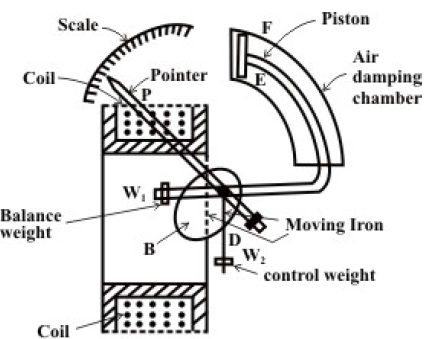Construction Of Moving-iron Instruments
Construction of Moving-iron Instruments: The deflecting torque in any moving-iron instrument is due to forces on a small piece of magnetically ‘soft’ iron that is magnetized by a coil carrying the operating current. In repulsion (Fig.42.7) type moving–iron instrument consists of two cylindrical soft iron vanes mounted within a fixed current-carrying coil. One iron vane is held fixed to the coil frame and other is free to rotate, carrying with it the pointer shaft. Two irons lie in the magnetic field produced by the coil that consists of only few turns if the instrument is an ammeter or of many turns if the instrument is a voltmeter. Current in the coil induces both vanes to become magnetized and repulsion between the similarly magnetized vanes produces a proportional rotation. The deflecting torque is proportional to the square of the current in the coil, making the instrument reading is a true ‘RMS’ quantity Rotation is opposed by a hairspring that produces the restoring torque. Only the fixed coil carries load current, and it is constructed so as to withstand high transient current. Moving iron instruments having scales that are nonlinear and somewhat crowded in the lower range of calibration. Another type of instrument that is usually classed with the attractive types of instrument is shown in Fig.42.8.
 ----fig(A) repultion type
----fig(A) repultion type ---------fig(B)attraction type
---------fig(B)attraction type
This instrument consists of a few soft iron discs (B) that are fixed to the spindle (D), pivoted in jeweled bearings. The spindle (D) also carries a pointer (P), a balance weight (W1), a controlling weight (W2) and a damping piston (E), which moves in a curved fixed cylinder (F). The special shape of the moving-iron discs is for obtaining a scale of suitable form.
Remark: Moving-iron vanes instruments may be used for DC current and voltage measurements and they are subject to minor frequency errors only. The instruments may be effectively shielded from the influence of external magnetic fields by enclosing the working parts, except the pointer, in a laminated iron cylinder with laminated iron end covers.